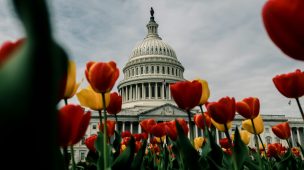23 March: What’s going on in ESG and insurance?
23 March, 2023
Welcome to our ESG roundup, keeping you up to date on the insurance industry’s most significant ESG-related news. The week’s topic: The continued development of ESG despite challenges in the US
Read our summary and analysis below.
Analysis
The continued development of ESG despite challenges in the US
In previous newsletters we have highlighted the toxicity of the term “ESG” in the US and the broader challenges facing those incorporating climate and other non-financial considerations in investment or underwriting decisions.
However, this is not stopping the Sustainability drive across the global insurance market. Just in the past two weeks, we see the drivers for action on ESG and sustainability continuing to develop in the same direction:
- Increased regulatory movement: e.g. the Bank of England is scrutinising climate risk more closely; FCA are pushing on improvements to ESG benchmarks; there is pressure to mandate TNFD reporting from a nature perspective; and we expect to see Lloyd’s provide feedback to syndicates on the ESG strategies they submitted as part of the business planning process last year. This is over and above the wide range of other regulatory requirements that are being developed.
- Investors & asset managers interested in sustainability: asset managers (e.g. BlackRock) continue to work on sustainability even if they avoid the ESG term
- Continued activism & potential ESG litigation: fossil fuel protests at Lloyd’s; concern about increased ESG litigation
- Leaders continue to drive ESG approaches forward: Zurich are excluding fossil fuel companies without credible transition plans; Munich Re strengthening their oil & gas activity reduction; Ariel Re adding carbon offset capabilities; IDF raising capacity
- Consumers want ESG as part of the offering: 80% of consumers want insurers to embed ESG initiatives into their proposition
Given how the underlying drivers of action on ESG in insurance continue to move forward, it would be a brave decision to punt ESG action into the long grass.
Summary
Increased regulatory movement
Bank of England report on climate-related risks and the regulatory capital frameworks (Bank of England)
The Bank of England recently published a report setting out its latest thinking on climate-related risks and regulatory capital frameworks. It includes updates on capability and regime gaps, capitalisation timelines and areas for future research and analysis.
As a short-term priority, the Bank is focused on ensuring firms make progress to address ‘capability gaps’ to improve their identification, measurement, and management of climate risks. Improving these areas will allow the reduction of the quantum of capital required in the future for resilience. The Bank also notes that the unique characteristics of climate risks mean that their capture by capital frameworks requires a more forward-looking approach than used for many other risks. According to current evidence, though, the existing horizons over which risks are capitalised by banks and insurers are appropriate. This means there is insufficient justification for regulators to change these time horizons.
Further work is needed to assess where there may be a regime gap in the macroprudential framework, where macroprudential regulation is that aimed at reducing systemic financial risk. Calibration of macroprudential tools would be challenging given uncertainties around climate risks and the need for them to help facilitate the transition to net-zero. The Bank also encourages greater public dialogue and research in this area.
Bank of England warns insurers of capital ‘uncertainty’ over climate risks (Insurance Times)
Reflecting on the Bank of England’s climate report, Insurance Times highlight the way in which the Bank warns about “uncertainty” around whether insurers are adequately capitalised against the threat of climate risks. While a previous report into Climate Change Adaptation published in October 2021 by the Bank said current frameworks already captured the risks to some extent, this new report exposes difficulties in estimating risks and the need for proper controls.
The Bank said it would continue to develop its strategy and capabilities to use climate scenario exercises to understand firms’ exposures to climate risks and drive further improvements in risk management.
FCA outlines where improvements are needed in ESG benchmarks (Financial Conduct Authority)
The FCA have completed a preliminary review on ESG benchmarks. This found that the overall quality of ESG-related disclosures made by benchmark administrators was poor. Issues identified include:
- Not enough detail on the ESG factors considered in benchmark methodologies
- Not ensuring that the underlying methodologies for ESG data and ratings products used in benchmarks are accessible, clearly presented and explained to users
- Not fully implementing ESG disclosure requirements
- Benchmark administrators failing to implement their ESG benchmarks’ methodologies correctly – for example, using outdated data and ratings or failing to apply ESG exclusion criteria
High quality ESG benchmarks are important to support trust in the market for ESG products and the transition to a net-zero economy.
Pension funds should ignite nature-positive investment, says Scottish Widows (Net Zero Investor)
In a new report Scottish Widows’ outline several policy and pension fund recommendations to convene industry action on this issue and enable nature-positive asset allocation throughout the financial services sector.
These include calling on the UK government and regulators to deliver transformative policy action that demonstrates leadership, supports mobilisation of nature-positive capital from the finance sector, and optimises cross-stakeholder collaboration.
Moreover, encouraging pension funds to consider the systemic risk of biodiversity loss and adopt the Taskforce on Nature-related Financial Disclosures framework, which will support better pension outcomes, risk management, and decision making.
Finally, advocating for regulation of the voluntary carbon markets in the UK, to drive the setting of high-quality standards, help address the nature financing gap, and support actions on decarbonisation and preservation of nature.
Investors & asset managers interested in sustainability
No mention of ESG as BlackRock’s Fink drops long-awaited annual letter (Responsible Investor)
Larry Fink mounted a defence of BlackRock’s actions on the energy transition in his long-awaited annual letter published on Wednesday, but explicit mentions of ESG were absent.
The introduction, which heavily emphasises the theme of choice, dances around the topic of the ESG backlash in the US, but does not address it explicitly. “There are many people with opinions about how we should manage our clients’ money,” says Fink. “But the money doesn’t belong to these people. It’s not ours either. It belongs to our clients, and our responsibility and our duty is to them.
“We see opinions diverging across regions – including the US and Europe – and even within regions – especially in the US.” He notes that this creates challenges for the “truly global” BlackRock. However, he claims that the firm’s diverse offerings, global perspectives and client-centric approach remain “powerful competitive advantages”.
Continued activism & potential ESG litigation
Activists hold fossil fuel protests at Lloyd’s of London (Insurance Times – subscription required)
Environmental protest group Mother’s Rise Up have staged a Mother’s Day-themed protest outside Lloyd’s of London in a call for Lloyd’s to cease its alleged coverage of new fossil fuel projects in the North Sea.
Leaders continue to drive ESG approaches forward
Munich Re hails reduction in oil and gas activity across insurance business in 2022 (ESG Insurer – subscription required)
Munich Re saw reductions in activities relating to coal-fired power plants and thermal coal extraction of 29 percent and 37 percent respectively in 2022. This was the company’s first year of quantifying environmental impacts in insurance business.
Ariel Re adds carbon offset capabilities in latest $125mn Titania Re cat bond issuance (The Insurer – subscription required)
Ariel Re has sponsored a third catastrophe bond issued by Bermuda special purpose insurer Titania Re providing $125mn of collateralised reinsurance cover for named storms and earthquakes, adding a carbon offset feature for replacement of buildings and vehicles.
In the event that a significant hurricane or earthquake event requires a large number of homes, commercial properties and vehicles to be replaced, Ariel Re will look to purchase carbon offset options from qualified providers to generate carbon credits.
There is currently no rule in the cat bond market stipulating that replacements must have lower carbon emissions.
Consumers want ESG as part of the offering
Insurance must rethink its role as ‘traditional premise’ no longer enough – survey (Insurance Business)
A recent survey of 30,000 people in 14 countries found that a majority (80%) of consumers want insurers to embed ESG initiatives into their proposition. Consumers are looking to insurance companies to act on the world’s biggest challenges such as climate change, ageing populations, and healthcare gaps. This shows that attitudes and behaviours around insurance are increasingly purpose-driven and prevention-focused.
However, although respondents expressed an overwhelming preference for risk prevention services in auto, home, life, and health insurance, few use the current offerings in the market. Only 4.3% in the US, and the 2.1% UK said they took up the services from their insurers.
Collaboration
Why is collaboration key to improving ESG data for underwriting? (Lloyd’s Market Association)
Quality data and ESG factors are both now critical to underwriting performance. However, the use of third-party ESG data is early in its development partly because data providers are not yet meeting underwriters’ detailed needs.
According to a survey conducted by the London Market Association, a great majority use external ESG datasets to inform investment portfolios. However, the way this data is used varies widely from simply passive monitoring at one end of the spectrum to incorporation into complex formulae to limit ESG risk exposure.
When it came to underwriting, though, only 52% of respondents used ESG data in decision-making. Even then, the application of such data is still in its early stages or is used largely for information only. Further, the supply of data is from fragmented sources with no clear frontrunners which underwriters consistently find valuable. This suggests an immature state of supply and usage.
Another reason for this is that granular ESG data is not as available for investment assets than for insured businesses. It underlines that underwriting firms need to define the data they want from suppliers (and ultimately insureds) more clearly, and to understand better how they might use it.
There is an urgent need for deeper independent research to better determine the relationship between ESG scores and insurance risk. The LMA see the furtherance of this agenda as a key priority for the year.
IDF expected capacity rises to $2.2bn as latest round of projects unveiled (ESG Insurer – subscription needed)
The IDF have revealed in its annual report that the total risk capacity offered or expected through the Insurance Development Forum (IDF)’s Tripartite Agreement with the UNDP and the German government has reached $2.2bn.
The scheme, which is aiming to reach $5bn in offered capacity to 500 million vulnerable people by 2025, is expected to reach 44 percent of its capacity target based on projects currently in development. Having already launched insurance mechanisms in Peru, Ghana, Mexico, Colombia and Nigeria, the IDF have revealed details of five new projects. These include a scheme to provide cover in Argentina, an agriculture scheme in Colombia and a $100mn capacity project in Uzbekistan.
About the author
Miqdaad Versi is a Partner and Head of Sustainability at Oxbow Partners. He leads engagements on sustainability strategy and delivery for some of the world’s largest (re)insurers. He has a wide network spanning the executive and sustainability leaders teams of large (re)insurers, industry bodies, and other organisations such as the United Nations Environmental Programme and the Insurance Development Forum.
Get market insights straight to your inbox


